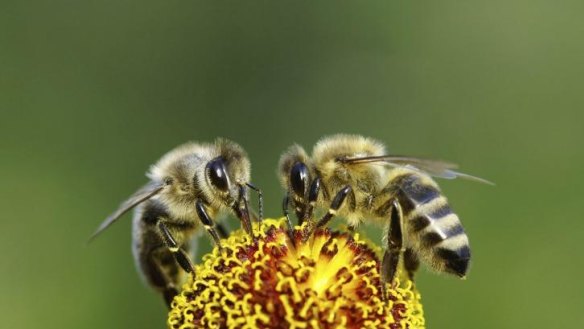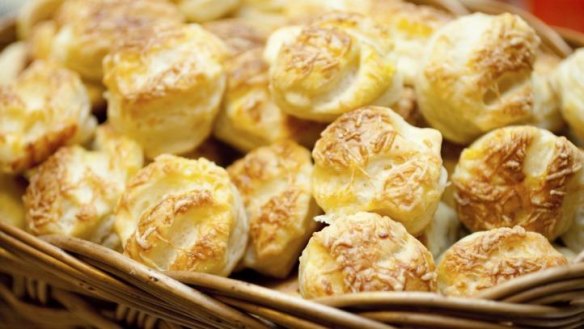Bees are a Canberra gardener's best friend

Springtime is a critical time for the growing of all fruits and vegetables. What happens when the flowers open? Well it depends so much on the weather but also on the insects that do the work of pollinating so many of the flowers, the blossoms. Bees are the only insect that provide humans with a continual food supply and that could be considered as liquid gold.
It is not only the setting of the fruit but also in ensuring production of the seeds in most flowering plants. Bees and other little flying insects transfer pollen from the male parts of a flower to the female parts of flowers in the same species, so fertilising the plant ovaries and starting the production of seeds for the next generation.
Bees are by far the most important of all insect pollinators. They spend much of their short lives collecting pollen. They tend to concentrate on the one type of flowering plant and with their legs covered with hairs they carry much pollen from flower to flower. They are vital companions for all fruit and vegetable growers in the springtime.

Growers of pears and apples, almonds and cherries, raspberries and strawberries are completely dependent on bees to pollinate their crops. Growers of peas and beans, pumpkins, cucumber and zucchinis are also totally reliant on the work of the humble bee to produce good crops.
In recent times there have been major factors at work that have had a very severe impact on both honeybees and native bees. Landscape clearance, use of toxic chemicals in agriculture, drought seasons and extreme winter conditions, and diseases have decimated many hives both here and overseas. The Rural Industries Research and Development Corporation and Horticulture Australia are concerned about the threat from exotic pests and diseases, especially the highly destructive Varroa mite which can severely weaken honeybees by puncturing their soft tissues and leaving them susceptible to infections.
The European Union has recently banned the use of neonicotinoids for an initial two year period. This class of neuro-active insecticides have become agents of paralysis and death for pollen and nectar foraging insects. One particularly toxic version, clothianidin, caused a massive wipeout of bee colonies in Germany back in 2008 but it took solid research efforts by Professor Randolf Menzel and others, to establish the causal linkages.
Bees will forage actively for up to five kilometres from the hive. And they can visit up to 2,000 flowers in one day. They return and complete an amazing dance routine which tells the other bees about the distance and direction of their find. It is good to see that local apiarists in the Canberra region are encouraging urban bee keeping.
Home gardeners can be well serviced by hives that are dotted around the suburbs. However, home gardeners need to understand that any use of toxic chemicals will have a big negative impact on bees that visit. We have followed carefully the standards of organic agriculture to ensure that our bees are not destroyed by toxins. Bees are among the most sensitive insect groups to the impact of poisons.
During the drought years of recent times, we lost complete hives during the winter months, due to insufficient stored food supplies. Apiarists have three options when faced with such a situation. They can provide supplementary sugar syrup food supplies to each hive, to help build up stores before the cold days of winter set in. Alternatively, they can move the hives to coastal regions where the seasons will allow different foraging options. Another option which we can all assist with is the planting of shrubs and trees for bees to visit, trees that will produce pollen and nectar over many months of each year.
We have set about planting a wide selection of Australian natives so that our local native bees can forage more successfully in our own neighbourhood, for longer periods. Callistemons, grevilleas, melaleucas and westringias produce flowers of beauty and are also valuable for bees as nectar sources for the production of honey. We have also planted out some flowering eucalyptus trees but they do take some time to grow.
Fortunately we are surrounded with some 150-year-old river red gums (eucalyptus camaldulensis) which have made it through the drought years. When they have a good season and the 'honey flows are on' then the beehives will be bursting with kilos and kilos of sweet honey.
In the home garden, planting of lavenders, and herbs including basil, coriander and rosemary will provide good foraging for visiting bees. We can all play a part in setting up a diverse and positive local environment.
Pumpkin and honey scones
2 cups self raising flour
½ tsp ground nutmeg
½ tsp cinnamon
pinch of salt
30 gms butter
1 cup cooked pumpkin, cooled
1 tsp honey
1 tbs castor sugar
1 egg, beaten
milk, as required
Preheat oven to 220°C and grease or flour a baking tray. Sift flour, nutmeg, cinnamon and salt into a bowl then rub in the butter using fingertips and thumbs. Work in until the mixture resembles fine breadcrumbs. Make a well in the centre of the mixture, add mashed pumpkin, honey, sugar and egg.
Mix with a flat bladed knife adding milk, if necessary, to make a sticky dough. Turn out the dough onto a lightly floured surface and knead gently until smooth. Do not over-mix. Roll out the dough with a rolling pin until it is 2cm thick and then cut out the scones.
Place the scones onto a greased baking tray, side by side. Brush with milk. Bake for 12 to 15 minutes, until golden. Serve with butter.
This week in the garden
- Plant out coriander, dill, chervil, rocket and open leaf lettuces directly into prepared garden beds.
- Plant into seed raising trays a selection of celeriac, capsicums, eggplants and tomatoes.
- If you have grown or purchased early tomato seedlings, transplant into individual pots and keep in a warm, protected location for the next month.
- Clean off winter crops that have finished producing and mix the remains with grass clippings and animal manures to start new compost heaps. Turn compost heaps regularly and ensure there is adequate moisture, to speed up the process of decomposition.
- Hold off trimming back frost damaged plants, such as citrus, as the unseemly looking leaves will provide protection for new shoots coming through, if late frosts arrive.
Owen Pidgeon runs the Loriendale Organic Orchard near Hall.
Restaurant reviews, news and the hottest openings served to your inbox.
Sign up